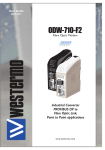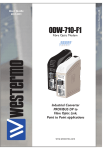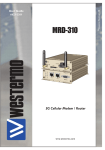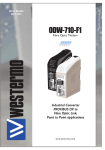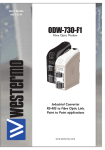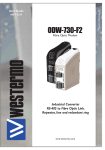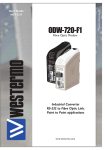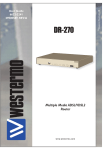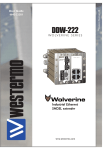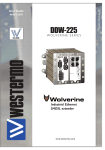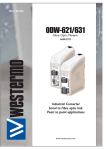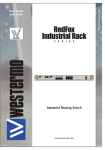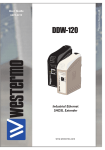Download Westermo ODW-710-F2 User guide
Transcript
6651-2211 ODW-710-F2 Fibre Optic Modem Industrial Converter PROFIBUS DP to Fibre Optic Link. Point to Point applications www.westermo.com © Westermo Teleindustri AB User Guide Legal information The contents of this document are provided “as is”. Except as required by applicable law, no warranties of any kind, either express or implied, including, but not limited to, the implied warranties of merchantability and fitness for a particular purpose, are made in relation to the accuracy and reliability or contents of this document. Westermo reserves the right to revise this document or withdraw it at any time without prior notice. Under no circumstances shall Westermo be responsible for any loss of data or income or any special, incidental, and consequential or indirect damages howsoever caused. More information about Westermo can be found at the following Internet address: http://www.westermo.com 2 6651-2211 Safety ! Before installation: Read this manual completely and gather all information on the unit. Make sure that you understand it fully. Check that your application does not exceed the safe operating specifications for this unit. This unit should only be installed by qualified personnel. This unit should be built-in to an apparatus cabinet, or similar, where access is restricted to service personnel only. The power supply wiring must be sufficiently fused, and if necessary it must be possible to disconnect manually from the power supply. Ensure compliance to national installation regulations. Branch circuit protection (fuse) is required for this unit with rating not exceeding 20 A. Product should be connected to UL Listed power supplies rated 12 – 48 VDC, min 500 mA or 24 VAC, min 500 mA or reliably grounded DC SELV source*. This unit uses convection cooling. To avoid obstructing the airflow around the unit, follow the spacing recommendations (see Cooling section). ! Before mounting, using or removing this unit: Prevent access to hazardous voltages by disconnecting the unit from the power supply. Warning! Do not open a connected unit. Hazardous voltages may occur within this unit when connected to a power supply. ! Class 1 Laser Product This unit is designed to meet the Class 1 Laser regulations. However, the user is warned not to look directly into fibre optical fibre port or any connected fibre. Care recommendations Follow the care recommendations below to maintain full operation of the unit and to fulfil the warranty obligations. This unit must not be operated with covers or lids removed. Do not attempt to disassemble the unit. There are no user serviceable parts inside. Do not drop, knock or shake the unit. Rough handling beyond the specification may cause damage to internal circuit boards. Do not use harsh chemicals, cleaning solvents or strong detergents to clean the unit. Do not paint the unit. Paint can clog the unit and prevent proper operation. Do not expose the unit to any kind of liquids (rain, beverages, etc). The unit is not waterproof. Keep the unit within the specified humidity levels. Do not use or store the unit in dusty, dirty areas. Connectors as well as other mechanical parts may be damaged. If the unit is not working properly, contact the place of purchase, nearest Westermo distributor office, or Westermo Tech support. Fibre connectors are supplied with plugs to avoid contamination inside the optical port. The plug should be fitted when no optical fibre is inserted in the connector, e.g. during storage, service or transportation. * Applicable for ODW-710-F2 only 6651-2211 3 Note. Fibre Optic Handling Fibre optic equipment requires careful handling as the fibre components are very sensitive to dust and dirt. If the fibre is disconnected from the modem, the protective plug on the transmitter/receiver must be replaced. The protective plug must be kept on during transportation. The fibre optic cable must also be protected in the same way. If this recommendation is not followed, it can jeopardise the warranty. Cleaning of the optical connectors In the event of contamination, the optical connectors should be cleaned by using forced nitrogen and some kind of cleaning stick. Recommended cleaning fluids: • Methyl-, ethyl-, isopropyl- or isobutyl-alcohol • Hexane • Naphtha Maintenance No maintenance is required, as long as the unit is used as intended within the specified conditions. Agency approvals and standards compliance Type Approval / Compliance EMC EN 61000-6-1, Immunity residential environments EN 61000-6-2, Immunity industrial environments EN 61000-6-3, Emission residential environments EN 61000-6-4, Emission industrial environments EN 55022, Emission IT equipment, class A EN 55024, Immunity IT equipment FCC part 15 Class A EN 50121-4, Railway signalling and telecommunications apparatus IEC 62236-4, Railway signalling and telecommunications apparatus Safety UL/CSA/IEC/EN 60950-1, IT equipment* EN 60950-1, IT equipment** ATEX** EN 60079-0 and EN 60079-15 * Applicable for ODW-710-F2 only ** Applicable for ODW-710-F2 Ex only FCC Part 15.105 Notice: This equipment has been tested and found to comply with the limits for a Class A digital device, pursuant to Part 15 of the FCC Rules. These limits are designed to provide reasonable protection against harmful interference when the equipment is operated in a commercial environment. This equipment generates, uses, and can radiate radio frequency energy and, if not installed and used in accordance with the instruction manual, may cause harmful interference to radio communications. Operation of this equipment in a residential area is likely to cause harmful interference in which case the user will be required to correct the interference at his own expense. EN 55022 Notice: This is a class A product. In a domestic environment this product may cause radio interference in which case the user may be required to take adequate measures. 4 6651-2211 ATEX Information (Applicable for ODW-710-F2 EX only) General This unit is intended for use in Zone 2 hazardous location only. Marking II 3 G Ex nA IIC T4 Gc SPECIAL CONDITION WARNING – DO NOT SEPARATE WHEN ENERGIZED Indicate that this unit complies with relevant European standards that are harmonised with the 94/9/EC Directive (ATEX). II 3 G Ex nA IIC T4 Gc SPECIAL CONDITION 6651-2211 Equipment group II. This unit can be installed in all places with an explosive gas atmosphere other than mines susceptible to firedamp Equipment category 3. A category is the classification according to the required level of protection. This unit ensures the requisite level of protection during normal operation and is intended for use in areas in which explosive atmosphere caused by gases, vapours, mists, or dust mixtures are unlikely to occure or, if they do occure, are likely to do so only infrequently and for a short periode only. Indicates protection concerning explosive atmospheres caused by gases, vapours or mists (G). Indicates that this unit is in conformity with relevant European Ex standard(s). Type of protection used. This unit is a non-sparking device "nA" which is constructed to minimize the risk of occurence of arcs or sparks capable of creating an ignition hazard during conditions of normal operation. Gas group, a typical gas i hydrogen. Temperature class T4 (T4 = 135°C). This unit is classified in accordance with its maximum surface temperature (external and internal). Equipment protection level Gc (EPL Gc). Equipment for explosive gas atmospheres, having a "enhanced" level of protection, which is not a source of ignition in normal operation and which may have some additional protection to ensure that it remains inactive as an ignition source in the case of regular expected occurences. EPL Gc are analogous to the ATEX Categories (Category 3 G = EPL Gc). This unit has a special condition of use. The special condition for safe use contains safety related information that is necesarry for the correct installation and safe use. 5 Ratings Power Ambient temperature Ingress protection (IP) Maximum surface temperatur (12 – 48) VDC; 400 mA –40ºC ≤ Ta ≤ +60ºC IP21 135ºC (temperature class T4) Safety Control Drawing Degree of protection Ambient temperature Installation spacing IP 21 –40°C to +60°C Minimum 25 mm above / below Minimum 10 mm left / right Direction relative this unit! Position 1 2 3 Descripton In & out / Relay contact (NO) In & out / Relay contact (C) In & out / Relay contact (NC) Input / Output values Uin = 60 VDC max Iin = 500 mA max Galvanically isolated via mechanical relay. See user manual for proven transient protection. Descripton –/– –/– In/out / RxD/TxD-P Out / CNTR-P – / DGND Out / VP –/– In/Out / RxD/TxD-N Not connected Input / Output values Umax = ± 5 Vpk Imax = ± 400 mA Data rate: 9600 bit/s to 12 Mbit/s 123 4 Position 1 2 3 4 5 6 7 8 9 Position Descripton Rx In / Receive port Tx Out / Transmit port Position Descripton 1 In / Common 2 3 4 In / +Voltage A In / +Voltage B In / Common Output values Max 0 dBm Input values Uin = (10 – 60) VDC Iin = 550 mA max PIn = Max 5.5 W See section Type tests and environmental conditions in this user manual for proven transient protection. 6 6651-2211 SPECIAL CONDITION FOR SAFE USE Ambient temperature: This unit is designed for use in extreme ambient temperature conditions as follows: –40 ºC ≤ Ta ≤ +60 ºC Installation in an apparatus cabinet: This unit requires installation in an Ex certified apparatus cabinet suitable for the area of use and providing a degree of protection of at least IP54. Resistance to impact: This unit requires installation in an apparatus cabinet where adequate resistance to impact is provided by the apparatus cabinet. See "Installation in an apparatus cabinet" above for requirements on the external apparatus cabinet. Resistance to light: This unit requires installation in an apparatus cabinet where it is protected from light (for example daylight or light from luminaires). See "Installation in an apparatus cabinet" above for requirements on the external apparatus cabinet. Secureness of plugs: When this unit is installed in an explosive atmospheres, all connectors must be mechanically secured to prevent loosening. Conductor temperature: When this unit is installed in locations with high ambient temperature, special precautions shall be taken upon the choice of external conductors and the temperature rating of the conductor(s). Directive 94/9/EC alongside with other directives: Directive 2004/108/EC (EMC) applies and to assure a safe performance of this unit under the scope of Directive 94/9/EC, refer to the electromagnetic immunity level specified under "Type tests and environmental conditions" in this manual. Standards and date of compliance EN 60079-0 and EN 60079-15 2010-12-17 6651-2211 7 Declaration of Conformity Westermo Teleindustri AB Declaration of conformity The manufacturer Westermo Teleindustri AB SE-640 40 Stora Sundby, Sweden Herewith declares that the product(s) Type of product Model Art no Industrial fiberoptic repeaters/media converters ODW-700 series 3651-07xx ODW-700EX series 3651-37xx is in conformity with the following EC directive(s). No Short name 2004/108/EC 94/9/EC1 Electromagnetic Compatibility (EMC) Equipment Explosive Atmospheres (ATEX) References of standards applied for this EC declaration of conformity. No EN 61000-6-1 Title Electromagnetic compatibility – Immunity residential environments Issue 2007 EN 61000-6-2 Electromagnetic compatibility – Immunity industrial environments 2005 EN 61000-6-3 Electromagnetic compatibility – Emission residential environments 2007 EN 61000-6-4 2007 EN 55022 Electromagnetic compatibility – Emission for industrial environments Information technology equipment - Emission EN 55024 Information technology equipment - Immunity EN 50121-4 Railway applications – Electromagnetic compatibility – Emission and immunity of the signalling and telecommunications apparatus Explosive atmospheres – Equipment – General requirements 1998 + A1:2001 + A2:2003 2006 EN 60079-0 EN 60079-15 Electrical apparatus for explosive gas atmospheres – Construction, test and marking of type of protection “n” electrical apparatus The last two digits of the year in which the CE marking was affixed: 2006 + A1:2007 2009 2005 11 Pierre Öberg Technical Manager 15th June 2011 1 8 Applicable for ODW-700EX series only. Postadress/Postal address Tel. Telefax Postgiro Bankgiro Org.nr/ Corp. identity number Registered office S-640 40 Stora Sundby Sweden 016-428000 Int+46 16428000 016-428001 Int+46 16428001 52 72 79-4 5671-5550 556361-2604 Eskilstuna 6651-2211 Type tests and environmental conditions Electromagnetic Compatibility Phenomena Test ESD EN 61000-4-2 RF field AM modulated IEC 61000-4-3 RF field 900 MHz Fast transient ENV 50204 EN 61000-4-4 Surge EN 61000-4-5 RF conducted EN 61000-4-6 Pulse Magnetic field Voltage dips and interruption EN 61000-4-9 EN 61000-4-11 Mains freq. 50 Hz Mains freq. 50 Hz Radiated emission EN 61000-4-16 SS 436 15 03 EN 55022 FCC part 15 EN 55022 FCC part 15 EN 55022 EN 60950 Conducted emission Dielectric strength Environmental Temperature Shock Packaging Enclosure, ODW-710-F2 Enclosure, ODW-710-F2 EX Dimension W x H x D Weight Degree of protection Cooling Mounting 6651-2211 Enclosure Signal ports Power ports Signal ports unbalanced Signal ports balanced Power ports Signal ports Power ports Enclosure AC power ports Signal ports Signal ports Enclosure AC power ports AC power ports DC power ports Signal port to all other isolated ports Power port to other isolated ports IEC 60068-2-6 Operating Storage & Transport Maximum surface temperature Operating Storage & Transport Operating Operating Operating IEC 60068-2-27 Operating UL 94 PC / ABS Cabelec 6141 Humidity Altitude Service life Vibration Description Enclosure contact Enclosure air Enclosure IEC 529 Enclosure Level ± 6 kV ± 8 kV 10 V/m 80% AM (1 kHz), 80 – 800 MHz 20 V/m 80% AM (1 kHz), 800 – 1000 MHz 20 V/m 80% AM (1 kHz), 1400 – 2700 MHz 20 V/m pulse modulated 200 Hz, 900 ± 5 MHz ± 2 kV ± 2 kV ± 2 kV line to earth, ± 2 kV line to line ± 2 kV line to earth, ± 1 kV line to line ± 2 kV line to earth, ± 2 kV line to line 10 V 80% AM (1 kHz), 0.15 – 80 MHz 10 V 80% AM (1 kHz), 0.15 – 80 MHz 300 A/m, 6.4 / 16 µs pulse 10 & 5 000 ms, interruption 200 ms, 40% residual voltage 500 ms, 70% residual voltage 100 V 50 Hz line to earth 250 V 50 Hz line to line Class B Class A Class B Class B Class A 2 kVrms 50 Hz 1min 3 kVrms 50 Hz 1min 2 kVrms 50 Hz 1min (@ rated power < 60V) –40 to +60°C –40 to +70°C 135ºC (temperature class T4) 5 to 95% relative humidity 5 to 95% relative humidity 2 000 m / 70 kPa 10 year 7.5 mm, 5 – 8 Hz 2 g, 8 – 500 Hz 15 g, 11 ms Flammability class V-1 35 x 121 x 119 mm 0.26 kg IP 21 Convection Horizontal on 35 mm DIN-rail 9 Functional description Switches LED’s POWER +VA +VB COM O V P Internal Electronics O V P NO C NC PROFIBUS DP RxD/TxD-P RxD/TxD-N SHIELD COM STATUS O C P SFP Fibre transceiver SFP Fibre transceiver CH 1 TX RX CH 2 TX RX OVP Over Voltage Protection OCP Over Current Protection Converter PROFIBUS DP – optical fibre ODW-710-F2 is a fibre optic modem that converts between electrical PROFIBUS DP and a fibre optical link. Repeater – optical fibre links ODW-710-F2 is a fibre optic repeater that repeats received data from one fibre link out to the other link. This is useful e.g. for long distance communication, where electromagnetic interference may occur or when isolation of the electrical network is needed. The maximum optical fibre distance depends on selected fibre transceiver and fibre type. Distances up to 80 km (50 miles) are available. Data rate up to 12 Mbit/s ODW-710-F2 converts PROFIBUS DP data using data rates from 9 600 bit/s up to 12 Mbit/s. Retiming of the PROFIBUS DP data ensures that the correct signal form is transmitted from the ODW-710-F2 converter. Automatic data rate detection The PROFIBUS data rate is set automatically as soon as the ODW-710-F2 receives a correct data frame, whether data is received from PROFIBUS DP or the fibre optic link. The detected data rate remains until a number of consecutive faulty received frames have been detected or no further frames are detected within the timeout period. The timeout period is set by switches, with the default setting of 31 faulty frames or 5 seconds without any received frames. 10 6651-2211 Interface specifications Power Rated voltage Operating voltage Rated current Rated frequency Inrush current I2t Startup current* Polarity Redundant power input Isolation to Connection Connector size Shielded cable ODW-710-F2: 12 to 48 VDC and 24 VAC ODW-710-F2 Ex: 12 to 48 VDC ODW-710-F2: 10 to 60 VDC and 20 to 30 VAC ODW-710-F2 Ex: 10 to 60 VDC 400 mA @ 12 VDC 200 mA @ 24 VDC 100 mA @ 48 VDC ODW-710-F2: DC and 48 to 62 Hz ODW-710-F2 Ex: DC 0.2 A2s 1.0 Apeak Reverse polarity protected Yes PROFIBUS DP and Status port Detachable screw terminal 0.75 – 2.5 mm2 (AWG 18 – 13) Connect the unit using at least 18 AWG (0.75 mm2) wiring Not required * External supply current capability for proper startup Status Port type Rated voltage Operating voltage Contact rating Contact resistance Isolation to Connection Connector size Shielded cable 6651-2211 Signal relay, changeover contacts Up to 48 VDC Up to 60 VDC 500 mA @ 48 VDC < 50 mW PROFIBUS DP and Power port Detachable screw terminal 0.2 – 2.5 mm2 (AWG 24 – 13) Not required 11 PROFIBUS DP (RS-485) Electrical specification Data rate Data format Protocol Data Rate detection Retiming Turn around time Transmission range Settings Protection Isolation to Connection Shielded cable Conductive housing EIA RS-485 / EN 50 170 9 600 bit/s, 19.2, 93.75, 187.5, 500 kbit/s, 1.5, 3, 6 and 12 Mbit/s 8 data bits, even parity, 1 stop bit, 11 bits total PROFIBUS DP / EN 50170 Yes, compliant with EN 50 170 Yes In accordance with EN 50 170 ≤ 1200 m, depending on data rate and cable type (EIA RS-485) None, external termination and failsafe biasing Installation Fault Tolerant (up to ±60 V) Power and Status port 9-pin D-sub female Not required Isolated to all other circuits and housings Optical Power Budget The allowed link length is calculated from the optical power budget (OPB), the available optical power for a fibre-optic link, and the attenuation of the fibre, comprising losses due to in-line connectors, splices, optical switches and a margin for link ageing (typical 1.5 dB for 1300 nm). The worst-case optical power budget (OPB) in dB for a fibre-optic link is determined by the difference between the transmitter’s output optical power (min) and the receiver input sensitivity (max). FX (Fibre) Fibre connector Fibre type Wavelength Transmitter Output optical power min/max Receiver Input sensitivity, max Receiver Input optical power, max Optical power budget, worst-case Transceiver type Laser class 12 SM-LC80 LC duplex Singlemode 9/125 mm 1550 nm –5/0 dBm SM-LC40 LC duplex Singlemode 9/125 mm 1310 nm –5/0 dBm SM-LC20 LC duplex Singlemode 9/125 mm 1310 nm –15/–8 dBm –35 dBm –35 dBm –34 dBm MM-LC2 LC duplex Multimode, 62.5/125 mm 1310 nm –20/–14 dBm –31 dBm 0 dBm 0 dBm 0 dBm –8 dBm 30 dB 30 dB 19 dB 11 dB Small Form Factor Pluggable (SFP) Multi-Sourcing Agreement (MSA) compliant Class 1, IEC 825-1 Accessible Emission Limit (AEL) 6651-2211 FX (Fibre) Fibre connector Fibre type Wavelength nm, connector 1 Wavelength nm, connector 2 Transmitter Output optical power min/max Receiver Input sensitivity, max Receiver Input optical power, max Optical power budget, worst-case Bit error rate (BER) Transceiver type Laser class 6651-2211 Bi-Di LC-40 LC Simplex Singlemode 9/125 μm Tx 1310, Rx 1550 Tx 1550, Rx 1310 –8/0 dBm Bi-Di LC-20 LC Simplex Singlemode 9/125 μm Tx1310, Rx 1550 Tx 1550, Rx 1310 –14/8 dBm –34 dBm –32 dBm –3 dBm 0 dBm 26 dB 18 dB < 1 x 10-10 < 1 x 10-10 Small Form Factor Pluggable (SFP) Multi-Sourcing Agreement (MSA) compliant Class 1, IEC 825-1 Accessible Emission Limit (AEL) 13 Location of Interface ports, LED’s and DIP-switches ODW-710-F2 LED Indicators(for details see page 15) DIP-switches accessible under lid (for details see page 16–17) Status screw terminal Position 1 2 3 Description Contact with C when fibre optical links are in operation Common Open (no contact with C) when fibre optical links are not in operation Product marking NO C NC PROFIBUS DP (RS-485) D-sub Position FX(Fibre) (for details see page 12–13) Direction* Description 1 – – 2 – – 3 In/Out RxD/TxD-P 4 Out CNTR-P 5 – DGND 6 Out VP 7 – – 8 In/Out RxD/TxD-N 9 – – Power screw terminal Position Direction* 1 2 3 4 In In In In Description Common voltage Voltage A Voltage B Common voltage Product marking COM +VA +VB COM * Direction relative this unit 14 6651-2211 LED Indicators LED PWR Power Status ON Flashing BA OFF ON Bus active CH 2 OFF ON Channel 2 link status Flashing OFF CH 1 ON Channel 1 link status Flashing OFF DPR Flash Receive PROFIBUS DP OFF FR Flash Receive fibre link OFF FL R ON Failure link remote Flashing FL L ON Failure link local Flashing 6651-2211 Description Power is on. Unit configured as focal point (DIP-switch S2:3 is ON). Power is off. Data rate has been identified and data frames are being received on the electrical or optical interface. Data rate has not been identified. Fibre link to other unit has been established at CH 2. Optical power detected but link to other unit has not been established at CH 2. No optical power detected and no link to other unit has been established at CH 2. Fibre link to other unit has been established at CH 1. Optical power detected but link to other unit has not been established at CH 1. No optical power detected and no link to other unit has been established at CH 1. Data received on the electrical interface and transmitted out on the optical interface. No data received on the electrical interface. Data received on the optical interface and transmitted out on the electrical interface. No data received on the optical interface. Remote fibre link failure. A fibre link is out of operation at any other unit than this one. Hardware error or invalid configuration. Local fibre link failure. A fibre link is out of operation at this unit. Hardware error or invalid configuration. 15 DIP-switch settings ! Before setting DIP-switches: Prevent damage to internal electronics from electrostatic discharges (ESD) by discharging your body to a grounding point (e.g. use of wrist strap). S1 S2 S2 DIP-switch ON 1 2 34 56 78 ON 1 2 34 56 78 ON 1 2 34 56 78 ON 1 2 34 56 78 16 Multidrop mid unit or redundant ring member. Multidrop end unit. E.g. the first or last unit in a multidrop network. Redundant ring master unit. Only one master unit allowed in a ring. 65535 tbit interruption in receiving frames, until inactive BA. ON 1 2 34 56 78 ON 1 2 34 56 78 ON 1 2 34 56 78 5 seconds interruption in receiving frames, until inactive BA*. 10 seconds interruption in receiving frames, until inactive BA*. 20 seconds interruption in receiving frames, until inactive BA*. *See section “About the automatic data rate detection” on page 25 for a more detailed description. 6651-2211 S1 DIP-switch S2 DIP-switch ON ON 1 2 34 56 78 1 2 34 56 78 ON ON 1 2 34 56 78 1 2 34 56 78 ON ON 1 2 34 56 78 1 2 34 56 78 ON ON 1 2 34 56 78 1 2 34 56 78 ON ON 1 2 34 56 78 1 2 34 56 78 ON ON 1 2 34 56 78 1 2 34 56 78 ON ON 1 2 34 56 78 1 2 34 56 78 ON ON 1 2 34 56 78 1 2 34 56 78 ON ON 1 2 34 56 78 1 2 34 56 78 ON ON 1 2 34 56 78 1 2 34 56 78 ON ON 1 2 34 56 78 1 2 34 56 78 ON ON 1 2 34 56 78 1 2 34 56 78 Description 1 faulty frame before data rate seen as unidentified*. S1: No extended retry limit. 2 faulty frames before data rate seen as unidentified*. S1: No extended retry limit. 3 faulty frames before data rate seen as unidentified*. S1: No extended retry limit. 4 faulty frames before data rate seen as unidentified*. S1: No extended retry limit. 5 faulty frames before data rate seen as unidentified*. S1: No extended retry limit. 6 faulty frames before data rate seen as unidentified*. S1: No extended retry limit. 7 faulty frames before data rate seen as unidentified*. S1: No extended retry limit. 8 faulty frames before data rate seen as unidentified*. S1: No extended retry limit. 31 faulty frames before data rate seen as unidentified*. S1: Extended retry limit. 63 faulty frames before data rate seen as unidentified*. S1: Extended retry limit. 127 faulty frames before data rate seen as unidentified*. S1: Extended retry limit. 255 faulty frames before data rate seen as unidentified*. S1: Extended retry limit. ON Set status port at local fibre link (FL L) error only. 1 2 34 56 78 ON ON 1 2 34 56 78 1 2 34 56 78 Factory default *See section “About the automatic data rate detection” on page 25 for a more detailed description. 6651-2211 17 Multidrop configuration RX2 TX2 TX1 RX2 TX1 RX2 TX1 RX2 RX1 TX2 RX1 TX2 RX1 TX2 End Unit S2: 2 ON PROFIBUS Master (PLC) TX1 RX1 End Unit S2: 2 ON PROFIBUS Slave PROFIBUS Slave PROFIBUS Slave Prepare the PROFIBUS units … Configure PROFIBUS network, with master and slaves. Check that the application is running correctly with the electrical PROFIBUS network. Note: In an ODW-710-F2 fibre optic network there will be some additional processing delays that do not exist in an electrical bus. It is possible that the PROFIBUS application must be adjusted to accommodate these delays if using many ODW-710-F2 units in a large network. See page 22 “Calculating system processing delay” for more information on how to determine the overall system delay time. Prepare the fibre optical network … The first and last ODW-710-F2 units must be configured as Multidrop end units by setting DIP-switch S2:2 to the ON position. (End units only have one fibre pair each and must know that this is a fact) … Connect the fibre pairs between the units. Always connect CH 1 from one unit to CH 2 on the next unit as shown in the picture above. … Connect the power supply to all units and verify that all fibre links become active. (CH 1 and CH 2 LED’s are on, FL L and FL R LED’s are off). … Connect the PROFIBUS master and slaves to the corresponding ODW-710-F2 unit. … The network is now up and running. Data from the PROFIBUS master is received at the ODW-710-F2 electrical port (as indicated by the DPR LED). The data rate is automatically detected (as indicated by the BA LED) and data bits are retimed according to the determined rate and sent out on the optical fibre at CH 1. The first ODW-710-F2 slave unit receives data at optical fibre CH 2 (as indicated by the FR LED). The data rate is automatically detected (as indicated by the BA LED) and data is sent out on the electrical port. The slave unit also repeats incoming data on CH 2 to the next slave unit. Responses from the PROFIBUS slaves are processed in the same fashion and sent back to the PROFIBUS master in the opposite direction. 18 6651-2211 Behavior during optical link failure RX2 TX2 TX1 RX2 TX1 RX1 TX2 RX1 RX2 TX1 RX2 TX2 RX1 TX2 Faulty segment End Unit S2: 2 ON FL R LED is on PROFIBUS Master CH 1 LED is off PROFIBUS Slave FL L LED is on TX1 RX1 End Unit S2: 2 ON CH 2 LED is off PROFIBUS Slave FL L LED is on FL R LED is on PROFIBUS Slave If an optical fibre segment fails, all communication with units beyond the faulty fibre segment will be lost. To determine witch fibre segment has failed, look at the FL L, CH 1 and CH 2 LED’s as show in the picture above. 6651-2211 19 Redundant ring configuration Fibre pair used to carry data. Redundant fibre pair. Not used under normal operation. RX2 TX1 RX2 TX1 RX2 TX1 RX2 TX1 TX2 RX1 TX2 RX1 TX2 RX1 TX2 RX1 Focal Point S2: 3 ON Ring Member Ring Member Ring Member PROFIBUS Slave PROFIBUS Slave PROFIBUS Slave PWR LED Flashing to indicate master PROFIBUS Master Prepare the PROFIBUS units … Configure PROFIBUS network, with master and slaves. Check that the application is running correctly with the electrical PROFIBUS network. Note: In an ODW-710-F2 fibre optic network there will be some additional processing delays that do not exist in an electrical bus. It is possible that the PROFIBUS application must be adjusted to accommodate these delays if using many ODW-710-F2 units in a large network. See page 22 “Calculating system processing delay” for more information on how to determine the overall system delay time. Prepare the fibre optical network … One, and only one, of the ODW-710-F2 units must be configured as a ring focal point by setting DIP-switch S2:3 to the ON position. (The ring focal point acts as a logical end point in the optical fibre ring, thus forming a bus type of structure) … Connect the fibre pairs between the units. Always connect CH 1 from one unit to CH 2 on the next unit as shown in the picture above. … Connect the power supply to all units and verify that all fibre links become active. (CH 1 and CH 2 LED’s are on, FL L and FL R LED’s are off). … Connect the PROFIBUS master and slaves to the corresponding ODW-710-F2 unit. Note: It is not required that the PROFIBUS master is connected to the ODW-710-F2 ring focal point, but it makes sense if one wishes to keep the installation “tidy” and easy to maintain. … The network is now up and running. 20 6651-2211 Data from the PROFIBUS master is received at the ODW-710-F2 electrical port (as indicated by the DPR LED). The data rate is automatically detected (as indicated by the BA LED) and data bits are retimed according to the determined rate and sent out on the optical fibre at CH 1. The first ODW-710-F2 ring member receives data at optical fibre CH 2 (as indicated by the FR LED). The data rate is automatically detected (as indicated by the BA LED) and data is sent out on the electrical port. The ring member also repeats incoming data on CH 2 out on CH 1 on to the next ring member. Responses from the PROFIBUS slaves are processed in the same fashion and sent back to the PROFIBUS master in the opposite direction. Behavior during optical link failure RX2 TX2 TX1 RX2 TX1 RX1 TX2 RX1 Focal Point S2: 3 ON PWR LED Flashing to idicate master FL R LED is on PROFIBUS Master (PLC) Ring Member CH 1 LED is off PROFIBUS Slave Faulty segment FL L LED is on RX2 TX1 RX2 TX1 TX2 RX1 TX2 RX1 Ring Member CH 2 LED is off PROFIBUS Slave Ring Member FL L LED is on FL R LED is on PROFIBUS Slave If an optical fibre segment fails, the ODW-710-F2 focal point will switch mode and start sending out data on both optical fibre ports, CH 1 and CH 2, simultaneously. Responses from the PROFIBUS slaves are sent back to the PROFIBUS master in the opposite direction, as normal. To determine witch fibre segment has failed, look at the FL L, CH 1 and CH 2 LED’s as show in the picture above. Note: If a fibre link fails there will be some time before the system reconfigures itself during witch data may be corrupted or lost. See page 23 “Reconfiguration time under faulty condition” for more information on how to determine the system reconfiguration time. 6651-2211 21 Calculating system processing delay Data exchange between a PROFIBUS DP master and slave via ODW-710-F2 fibre optic link will be delayed due to the length of the optical fibre and the signal processing within the ODW-710-F2. The signal processing delay is dependent on the data rate, and the fibre delay is dependent on the total length of the optical fibre. The additional time resulting from the optical fibre and ODW-710-F2 is the Overall system delay. Delay @ < 1.5 Mbit/s Delay @ 3 to 12 Mbit/s 5 µs/km 5 µs/km 1 tbit + 1 µs 9 tbit + 1 µs Signal processing, fibre to electrical (max) 0.3 µs 0.3 µs Signal processing, fibre to fibre (max) 1.3 µs 1.3 µs Optical fibre length delay (typical) Signal processing, electrical to fibre (max) Note tbit = 1 / Baud rate (Baud rate in bit/s) Example One PROFIBUS DP master and 11 slaves with data rate 12 Mbit/s. 12 ODW-710-F2 units with a total fibre length of 40 km. A data frame sent from the master to a slave at the farthest end of the optical network. 1. Optical fibre length delay: The total optical fibre length delay. 40 x 5 µs = 200 µs 2. Signal processing electrical to fibre: Signal processing delay (ODW-710-F2 units connected to PROFIBUS DP master). 9 tbit + 1 µs= 9 x 0.083 µs + 1 µs x 2 = 1.1 µs 3. Signal processing fibre to electrical: Signal processing delay (ODW-710-F2 units connected to PROFIBUS DP slave). 0.3 µs 4. Signal processing fibre to fibre: The optical repeater delay x Number of optical repeaters (excluding the ODW-710-F2 units connected to PROFIBUS DP master and addressed slave). (12 – 2) x 1.3 µs = 13 µs. 5. The system delay is calculated by summing the delays in item 1 to 4 above: 200 µs + 1.1 µs + 0.3 µs + 13 µs = 214 µs 22 6651-2211 Reconfiguration time under faulty condition The reconfiguration time is determined by the time it takes to detect a faulty fibre segment plus the time it takes to transport an error status message through to the ODW710-F2 focal point unit. The time to transport an error status message to the focal point unit is dependent on how many units the error status message has to be repeated through and the total fibre length delay. Delay Optical fibre length delay (typical) 5 µs/km Error detection 3 µs Error repeater delay 0.8 µs During reconfiguration data may be corrupted or lost. Example A system with one PROFIBUS DP master, 11slaves, 12 ODW-710-F2 units and a total fibre length of 2 km. The worst-case reconfiguration time would be: 1. Optical fibre length delay: The total optical fibre length delay. 2 x 5 µs = 10 µs 2. Error detection: The time it takes to detect a faulty fibre segment. Always 3 µs. 3. Optical repeaters: The optical repeater delay x Number of optical repeaters (excluding the ODW-710-F2 units connected to PROFIBUS DP master and addressed slave). (12 – 2) x 0.8 µs = 8 µs. 4. The reconfiguration time is calculated by summing the delays in item 1 to 3 above: 10 µs + 3 µs + 8 µs = 21 µs 6651-2211 23 About the interfaces Power The power terminal has two independent inputs, +VA and +VB, allowing redundant power input. The ODW-710-F2 power supply is galvanically isolated from all other interfaces. Optical fibre interfaces ODW-710-F2 uses Small Form Factor Pluggable (SFP) transceivers. This means that a wide range of different fibre transceivers and connectors can be used (see page 12–13). PROFIBUS DP interface The PROFIBUS DP interface is a female 9-position D-sub. Pin assignments are compliance with the PROFIBUS standard EN 50 170. Status port The status port connects to an internal relay witch may be used to trigger an external alarm if a fault condition occurs. During normal operation pins 1 and 2 are in contact with each other, and pins 2 and 3 are isolated. During an optical link failure, or power failure, pins 1 and 2 are isolated, and pins 2 and 3 are in contact with each other. Optical link failures can be classified in to two categories, local or remote, as indicated by the FL L and FL R LED’s. A local link failure is when an optical link is down at this particular unit. A remote link failure is when an optical link is down at some other unit. From the factory, the status port is set to trigger on both types of link failures. However, by setting DIP-switch S1:1 to the ON position, the status port will only trigger when a local link failure has occurred. 24 6651-2211 About the automatic data rate detection ODW-710-F2 automatically detects the data rate by monitoring incoming PROFIBUS data frames on both the electrical and optical interfaces. When the data rate has been established the BA LED will go active. If no data frames are transmitted for a period of time the automatic data rate detection will restart and the BA LED will go inactive. The idle time before the automatic data rate detection restarts is set using DIP-switches S2:4 and S2:5. The factory default setting is 5 seconds. The automatic data rate detection determines the actual data rate by listening for PROFIBUS Start Delimiters (SD1 – SD4) at the beginning of each data frame. If one or more Start Delimiters are lost the automatic data rate detection will rest start. The number of lost Start Delimiters before the automatic data rate detection restarts is set using DIP-switches S1:2 and S2:6 – S2: 8. The factory default setting is 31 faulty frames (31 lost Start Delimiters). Note: Start Delimiters can be lost during an electrical or optical disturbance. For example a PROFIBUS slave unit is connected/disconnected or an optical fibre is disconnected. It is advisable to start of by using the factory default settings and only manipulate them if a problem exists. 6651-2211 25 Mounting This unit should be mounted on 35 mm DIN-rail, which is horizontally mounted inside an apparatus cabinet, or similar. Snap on mounting, see figure. CLICK! CLICK! Cooling This unit uses convection cooling. To avoid obstructing the airflow around the unit, use the following spacing rules. Minimum spacing 25 mm (1.0 inch) above /below and 10 mm (0.4 inches) left /right the unit. Spacing is recommended for the use of unit in full operating temperature range and service life. 10 mm * (0.4 inches) * S pacing (left/right) recommended for full operating temperature range 25 mm 25 mm Removal Press down the black support at the top of the unit. See figure. 26 6651-2211 Westermo • SE-640 40 Stora Sundby, Sweden Tel +46 16 42 80 00 Fax +46 16 42 80 01 E-mail: [email protected] www.westermo.com Sales Units Westermo Data Communications China [email protected] www.cn.westermo.com France [email protected] www.westermo.fr Germany [email protected] www.westermo.de North America [email protected] www.westermo.com Singapore [email protected] www.westermo.com Sweden [email protected] www.westermo.se United Kingdom [email protected] www.westermo.co.uk Other Offices For complete contact information, please visit our website at www.westermo.com/contact or scan the QR code with your mobile phone. REV.E 6651-2211 2013-06 Westermo Teleindustri AB, Sweden – A Beijer Electronics Group Company




























